-
Paper Information
- Paper Submission
-
Journal Information
- About This Journal
- Editorial Board
- Current Issue
- Archive
- Author Guidelines
- Contact Us
Journal of Wireless Networking and Communications
p-ISSN: 2167-7328 e-ISSN: 2167-7336
2017; 7(3): 59-65
doi:10.5923/j.jwnc.20170703.02

Development of an Anonymous Key Exchange System for Roaming Services
Thompson Aderonke, Akinsowon Omoyele, Alese Boniface Kayode
Department of Computer Science, The Federal University of Technology, Akure, Nigeria
Correspondence to: Thompson Aderonke, Department of Computer Science, The Federal University of Technology, Akure, Nigeria.
| Email: |  |
Copyright © 2017 Scientific & Academic Publishing. All Rights Reserved.
This work is licensed under the Creative Commons Attribution International License (CC BY).
http://creativecommons.org/licenses/by/4.0/

The development of an anonymous key exchange system for roaming services is highly desirable to wireless users, but ensuring the security and efficiency of this process is challenging. The main issues have always been to secure the channels of communication and data from eavesdroppers and hackers. This research paper therefore focuses on the basic security concerns for establishing channels of communication between users and servers and proposes and implements a better method. This work is implemented using Visual Studio C# to develop a roaming application that allows the user to hop from networks to stronger networks.
Keywords: Roaming, Anonymous Key Exchange, Home server, Foreign server
Cite this paper: Thompson Aderonke, Akinsowon Omoyele, Alese Boniface Kayode, Development of an Anonymous Key Exchange System for Roaming Services, Journal of Wireless Networking and Communications, Vol. 7 No. 3, 2017, pp. 59-65. doi: 10.5923/j.jwnc.20170703.02.
Article Outline
1. Introduction
- In this present world of technologically advanced Computer Networks and Telecommunications system, user mobility has become an increasingly important feature. User mobility refers to a situation in which a user subscribed to a network in his or her own environment, can change to a different geographical location where the home servers’ network does not reach but the user can access the services of a totally different operator. [YWD07]. This phenomenon is called roaming. Traditionally, roaming is a handing over from one server (home server) to another (foreign/visited server) even when the two networks may not be the same type in order for a user to continue to get access to network services. So, users can be transferred from their home server to a foreign server seamlessly. The advantage of roaming is that users can have unlimited access to network services and a much broader network coverage and not be limited to that of their home servers alone. Roaming can be between different network devices. Roaming from a wireless local area network (WLAN) and a mobile network and vice versa is a good example. [Lam86]
1.1. Roaming
- Typically, roaming involves three parties, namely; the roaming user, the home server to which the user is subscribed to and the foreign or visited server. Before a user can access a foreign server, there has to be an agreement between it and the home server. The user is granted access to the foreign server’s resources only after an agreement is reached and the authentication process has been carried out. As a result of these developments, user privacy has become a top-notch security issue, especially in order to prevent unauthorized users from access. Generally, most users prefer to keep their real identity from eavesdroppers, even from the foreign server itself. An exposure of users’ identity can lead to further exposure of the users’ session for any time; whether the past or future. The method of hiding the users’ identity is called User Anonymity. Furthermore, it is of utmost importance that a user’s movement cannot be monitored or traced all through. Disclosure of a user’s identity can allow unauthorized persons to monitor his/her sessions and location. Gaining access to a user’s location without consent is outright violation of user privacy. The process in which no other party can identify previous sessions and protocol run except the user alone, not even the foreign server is called User Untraceability.
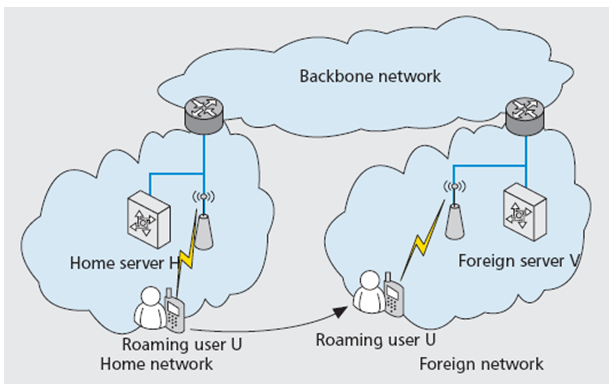 | Figure 1. Network Roaming |
1.2. Hypotheses
- 1. Can users be assured that their identities are concealed for their roaming sessions?2. Is the communication between users and the foreign servers secure and inaccessible to unwanted parties?This research is aimed at implementing the data roaming services through the development of an application using Visual Studio C# which automatically switches to the strongest wireless network available to it. The application does not need a total revelation of its identity to connect to the strongest network. It only needs to present the password of the network for connection so that the application can be verified by the network it is visiting.
2. Related Works
- What is a key? A key is just a parameter that is used to determine the output of a cryptographic algorithm. The key is very important to the deciphering of the algorithm because without it, the algorithm would be like any other, thereby yielding no useful result. We have the public key and the private key. The public key is a key in cryptography that can be got and used by anyone to encrypt messages in such a way that deciphering is only possible if the recipient has a second key (public key) which will be known to him only. The private key is a secret key that could be used for encryption or decryption by users involved in an exchange protocol. Basically, in cryptography, there are two types of key algorithms; symmetric key algorithms and the asymmetric key algorithms. The symmetric key algorithm uses the same key for both the encryption and decryption of information. This means this particular has to be kept secret and closely guarded from eavesdroppers and hackers else, once it’s gotten hold of, they’ll be able to decrypt and tamper with the information. The asymmetric algorithm makes of a pair of keys (public and private), one to encrypt the information (public key), and the other to decrypt it (private key).What is a key exchange system? A key exchange system in cryptography refers to a method through which cryptographic keys (whether public or private) are exchanged between users. These keys enable the user to be involved in the exchange of encrypted messages. While anonymous key exchange system refers to a situation where the users’ identity is hidden but can be verified and still go ahead to carry out the exchange.The basic problem with the key exchange system has always been how to exchange these keys without a third party accessing and decrypting their messages. This problem has given rise to a series of solutions over the past years but a most notable one is the Diffie-Hellmann key exchange method. [YAA06]. In the year 1976, Whitfield Diffie and Martin Hellmann jointly published this scheme. This method allows users without prior knowledge of one another to be able to establish a channel for communications through the establishment of a shared secret key. In order to implement Diffie-Hellmann, there has to be two users willing to communicate, say Steve and Eve. First Steve and Eve agree publicly on a prime modulus and a generator.Let g=3 and p=17. Then Steve selects a private random number, say 15 and calculates 315 mod 17≡ 6. Then Steve sends this result (6) to Eve. Eve also selects her private random number, say 13 and calculates 313 mod 17≡12 and sends this result (12) publicly to Steve. The trick of the whole scheme is that when either Steve or Eve raises each other’s transported results to the power of their private number, they arrive at the same answer.That is, For Steve: 1215 mod 17≡10 and For Eve: 613 mod 17≡10. With this agreed private answer, they can go ahead and share messages since no third party will be able to decrypt their messages without a private key.
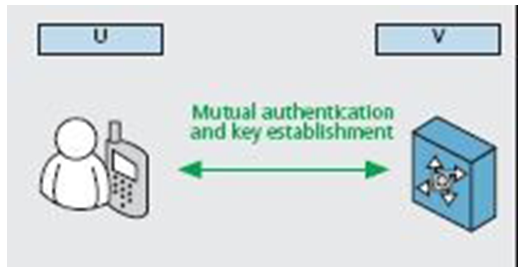 | Figure 2. Two-party Authentication Roaming |
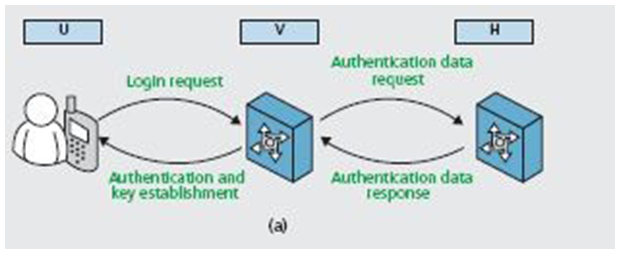 | Figure 3. Three-party Authentication Roaming |
3. Proposed Method
- There are basically two entities in this protocol; the roaming user which is the application and the foreign server which can be any other wireless network available at that instance. Knowing that AKE means Anonymous Key Exchange, let A and B represent the identities of the user and the server respectively. And let the key pairs of A and B be represented by (ZA; PA), (ZB; PB) respectively. ZA and ZB basically represent the private keys of A and B while the public keys for A and B are represented by PA and PB. The hidden identity of A which is one of the main causes of the project is given as [A]. If the generated key is given as Ω, then the Anonymous Key Exchange protocol is given by:
 The scope of this SAD is to show the architecture of the Wi-Fi Roaming application developed for the implementation of this work. The Wi-Fi Roam application based on the Windows Presentation Foundation technology by Microsoft was deployed on a Windows-based operating system environment. The system was secured so that a device can connect with any network anonymously. Hence, the following basic security behaviors were implemented:Ÿ Authentication: connecting to existing network using a WPAK-Secure password.Ÿ Confidentiality: sensitive data was encrypted (User).Ÿ Data integrity: Data sent across the network cannot be modified by a tier.Ÿ Persistence: The device will continually check for existing networks to connect to, in order to satisfy its roaming ability.Ÿ Reliability/Availability: The availability of the system is an important advancement for users of existing networks, as it is a roaming system. The candidate architecture must ensure failover capabilities. Reliability/Availability was addressed through the WPF platform.A device accesses the Wi-Fi Roam application and searches for the available networks. The device chooses from the list of networks judging by the strength of signal. Then, the device performs connection request with exchange of key/credentials. Once the key has been validated, device connects to the network, continues background scanning of networks with stronger signal and initiates re-connection to one if found.
The scope of this SAD is to show the architecture of the Wi-Fi Roaming application developed for the implementation of this work. The Wi-Fi Roam application based on the Windows Presentation Foundation technology by Microsoft was deployed on a Windows-based operating system environment. The system was secured so that a device can connect with any network anonymously. Hence, the following basic security behaviors were implemented:Ÿ Authentication: connecting to existing network using a WPAK-Secure password.Ÿ Confidentiality: sensitive data was encrypted (User).Ÿ Data integrity: Data sent across the network cannot be modified by a tier.Ÿ Persistence: The device will continually check for existing networks to connect to, in order to satisfy its roaming ability.Ÿ Reliability/Availability: The availability of the system is an important advancement for users of existing networks, as it is a roaming system. The candidate architecture must ensure failover capabilities. Reliability/Availability was addressed through the WPF platform.A device accesses the Wi-Fi Roam application and searches for the available networks. The device chooses from the list of networks judging by the strength of signal. Then, the device performs connection request with exchange of key/credentials. Once the key has been validated, device connects to the network, continues background scanning of networks with stronger signal and initiates re-connection to one if found.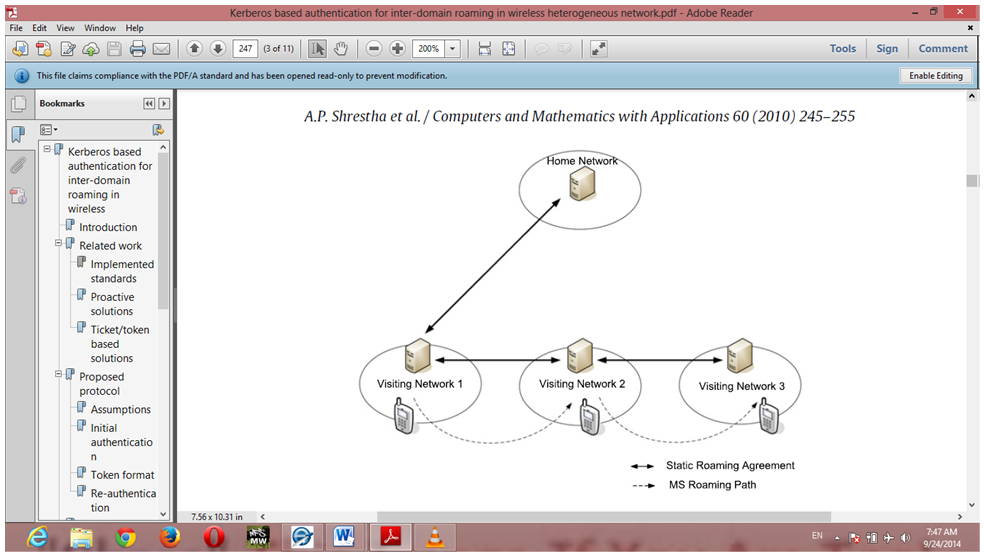 | Figure 4. Roaming User Visiting Networks of Various Signal Strengths |
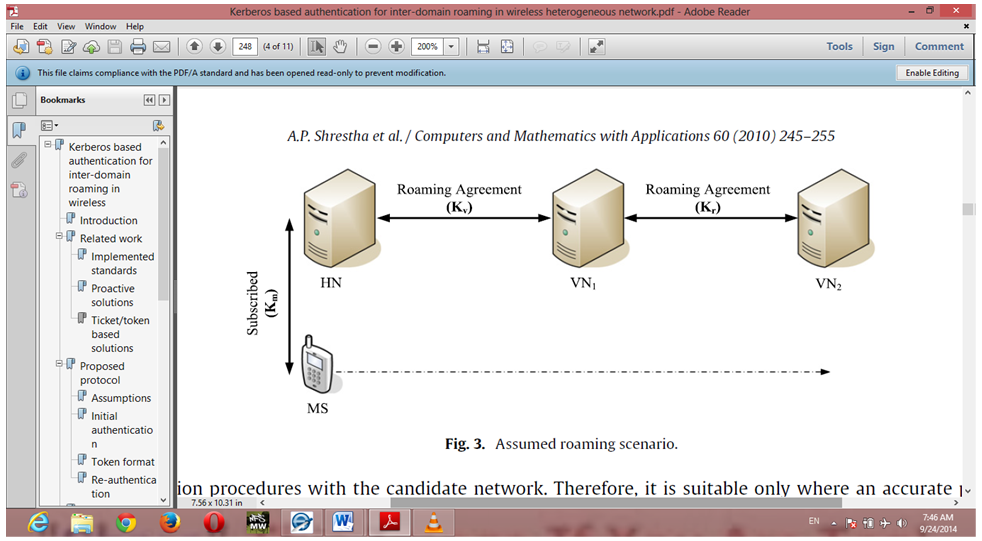 | Figure 5. User Home Network Establishing Key Agreement with Visited Networks |
|
4. Algorithm Description
4.1. Architectural Layer Dependencies
- The layering model of the Wi-Fi Roaming application is based on a responsibility layering strategy that associates each layer with a particular responsibility. This strategy has been chosen because it isolates various system responsibilities from one another, so that it improves system development.Each layer has specific responsibilities.Ÿ The presentation layer deals with the presentation logic and the pages rendering.Ÿ The control layer manages the access to the domain layer.Ÿ The resource layer (integration layer) is responsible for access to the network information (systems information, databases or other sources of information).Ÿ The domain layer is related to the server/host and manages the access to the networks.Ÿ The Common Elements layer gathers the common objects reused through all the layers.The Wi-Fi Roaming application is quite simple and only contains two basic features, one for the scanning and filtering networks and the other allowing a device to connect to a preferred network. Network services are reused for the network-scanning functionalities.Microsoft Visual C# was the major tool used in implementing this research work. In the development of the Wi-Fi Roam, there are 5 main horizontal tabs; the AnimationHelper, the ChannelBar, ChannelHeader, MainWindow and the Status Callback. These are all shown in the snapshot below Figure 7.Ÿ The Animation Helper: It simulates the scanning experience to show the user how foreign networks are scanned.Ÿ The Chanel Bar: The channel bar tab was developed to show the channels in which the discovered devices lie. It basically has 17 horizontal bars stacked side by side.
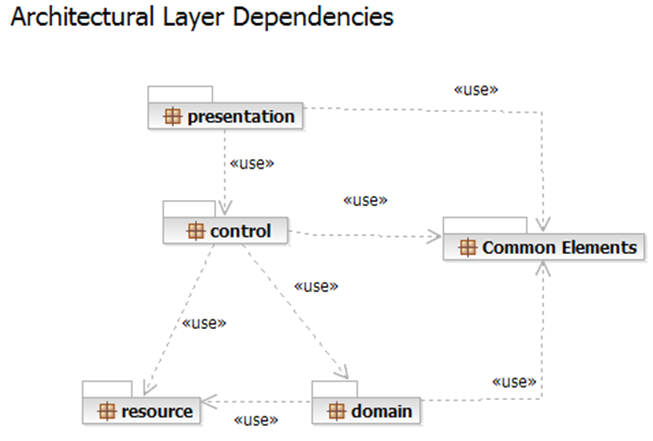 | Figure 6. Architectural Layer Dependencies |
 | Figure 7. Main Tabs |
 | Figure 8. The Channel Bar |
 | Figure 9. Code for the Channel Bar |
 | Figure 10. Networks available and within range |
5. Result and Discussion
- At the end of implementation, the application was able to search for network around, record the percentage of strength of the networks and switch to the strongest network. This roaming application reduces the stress that users have to go through to manually search for networks before connecting to the available ones. It automatically searches for the available networks for connection even while the user is connected to another network. This is done so that when the user disconnects or leaves the network coverage, it will be easy to connect to other networks. It also protects the user’s identity all through the period of roaming. This however can only be done after the user has been authenticated for connection to the foreign network. The application establishes a key with the foreign server in order to give a secure channel for communication, making sure that only authorized parties have access to them.
6. Conclusions
- In this work, focus was on anonymous roaming from network to network and trying to keep the identity of the users from eavesdroppers and hackers. Roaming services on wireless networks give people better and uninterrupted access to network services. This process should be fast enough to support demanding applications too.
 Abstract
Abstract Reference
Reference Full-Text PDF
Full-Text PDF Full-text HTML
Full-text HTML